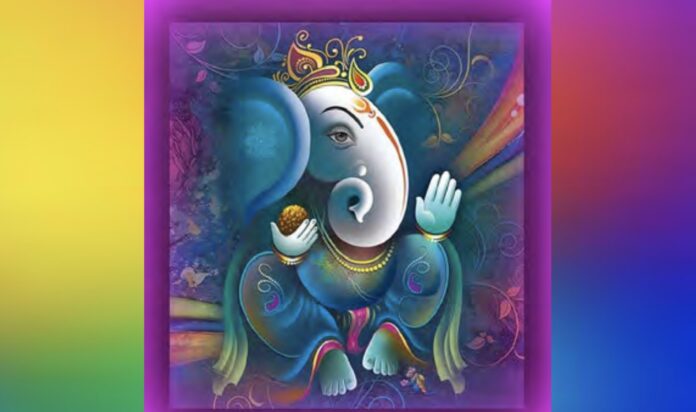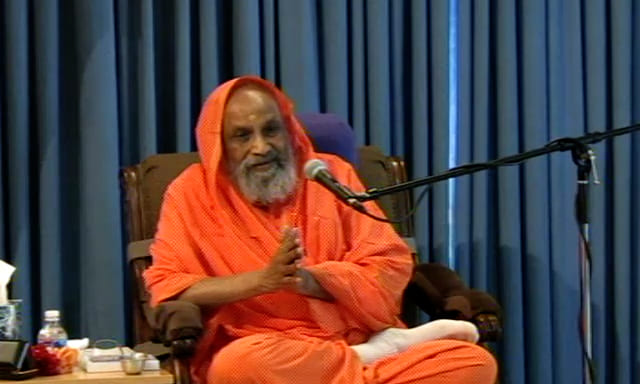Swami Dayananda Saraswati
Excerpt from classes on Patanjali’s Yoga Sutras at Arsha Vidya Gurukulam, Fall, 2000, transcribed and edited by Constance DiMartino
In preparation for meditation, I relax myself by being objective. If you follow closely what is said everyday in meditation, you will see that it is in keeping with a certain reality. There is no imagination involved in this. When you are asked to meditate on cakras, centers, there are two things you imagine. One is the cakra. You do not know what a cakra is, but you visualize a cakra, which is not a reality visualization; it is not like the visualization of a blue sky. Then on this cakra you superimpose something further. Originally, cakra meditation was devatā, deity, meditation. For the mulādhāra, the presiding deity is Gaṇapati, Ganeśa. So, first you imagine a mulādhāra, a cakra at the range of the naval, then on that you superimpose Ganeśa and meditate on Ganeśa. That is mediation. For all of the cakras there are deities, and on each one of them you superimpose a given deity and then meditate upon it. I don’t advise this for certain reasons. I avoid imagination as far as possible, because we already imagine a lot of things. I am trying to reduce subjectivity and then make people be aware of what is. Along the way, you cannot get lost like that—all the way the pursuit should be objective, because we are dealing with what is. We are not even dealing with what is possible. Possibilities are in the realm of saàsāra. In the realm of liberation, mokṣa, we are dealing with only what is. So, we are not tapping your potential; I don’t use that term. You will find many spiritual teachers talking about your potential, but I never mention it because potential is saàsāra. In this world, there are a lot of potentials and in life you can accomplish a lot of things. That is saàsāra. When you come to mokṣa-śāstra, we are not dealing with potentials at all. They are all karma-phala.
The only time I use the word “potential” is regarding prayer. Prayer taps the potential, which, for me, is grace. That aspect of yoga, éśvara-praṇidhāna, worship of Īśvara is a very important factor in this pursuit, because that aspect is also objective. How? If all that is here is Īśvara, that is how I have to see it. Thus, to see that is to be totally objective. And along the way I want a few things, which unfolds another thing. That is, there are many slips between the cup and the lips—and the stomach, also, because what goes to the lips can go to the windpipe. Therefore, I see that there are many hidden variables, and as an objective person I want to take care of them. That is what an objective, pragmatic person has to do. Being hidden, I don’t even know what they are, or how or when they are going to come. These hidden variables can run counter to what I want to accomplish in my life. And therefore, I have prayer. In life, whatever potential you want to tap is fine, and you include prayer to take care of the hidden variables. But prayer is something that I include, not only so that I can achieve things, but even in the spiritual pursuit. There too, there are a lot of hidden variables. And therefore, I include prayer objectively. Even in the Lord Dakṣiṇāmūrti form there is one fellow sitting there with a knife drawn—as a hidden variable. It is a part of the tradition. Religious life for me is relating to Īśvara, accepting Īśvara, so being objective, prayer, etc., is something that I cannot avoid.
Prayer that is purely mental is what we call meditation. And in order to pray effectively, I have to first surface the meditator. Who is doing meditation? The Gita helps us here in the last few verses of the fifth chapter of Gita, and the entire sixth chapter called “Yoga of Meditation.” Dhyāna, meditation, is the topic there, but if you read this chapter, you will find that these verses talk about who is the meditator. There is so much about the meditator. In Pataṅjali’s Yoga-sūtras, in yama, niyama, etc., it is the meditator who is talked about. Who is the person who is going to sit and meditate? How does one surface that person?
In the Bhagavad Gita we have this verse for those who are committed to mokṣa— bāhyān sparśān bahirkrtvā. The external world is taken as external. The meditator keeps the external world external, because we do internalize. This particular word, “internalizing” is, perhaps, a modern word, as a kind of a psychological term. Somebody calls you a name, and then you internalize it; you take it to heart. A criticism, a frown, a damaging remark, is internalized. This is what I call loading yourself with the external world. Because of this, everybody carries a few hurts, nurses them, and keeps the feeling of being hurt going. That will always be there until you take the sources of hurt as external. They have nothing to do with you; they are just dealing with their own problems. Each one of them has a background, and it is the background that makes the person. So I free myself from this load by unloading all the people who are inside—unloading people, situations, whatever bothers me, hurts me. I can keep them with me for my lifetime, or I can get rid of them. We have to get rid of them.
In certain cultures you are advised to ‘forgive’ them. I always feel that I am not qualified to forgive anybody. I have to be forgiven by people. Who am I to forgive? This concept of forgiveness is a Christian concept. Sin, guilt, and therefore, forgiveness all form a topic. “Reconciliation and Forgiveness” is a typical Christian topic. The Pope asked for forgiveness from the Lord—not from the people who were hurt, but from the Lord. He is asking forgiveness from the Lord, not the community of Jewish people who were destroyed in millions. The Church was a witness to that and did not try to stop it. And other communities, cultures, and villages were hurt, but did they ask each one of them, “We have done this and hereafter we won’t do it; please forgive us”? No. They ask the Lord to forgive. That means the people are left behind, so they can do the same thing, and another Pope can come and ask for forgiveness. I don’t believe in this forgiveness. I am not in a position to forgive anybody, and I need not forgive anybody. That is patronizing.
All I need is understanding. A person does something wrong to me because of his own pressure. So, I cover this step also in my understanding of the person—I understand that there is a background. That is a reality; that is Īśvara. Then nobody can hurt me. This is what I call a two-step response; it is so important. I have to fall back upon that and look at the whole thing as an order. That is understanding. Thereby, you unload the person from your heart and grant freedom to that person to be what he or she is. If you want, you can pray for that person to grow out of his own problems, but you are not going to nurse a hurt. Then you are free. The meditator is free from this inner load, and he must be free, because this inner load is not going to allow him to meditate. I visualize people who have hurt me from childhood onwards—father and mother first, who are the initial sources of hurt, and then some others later in life. I don’t ‘forgive’ any of them, but I grant them the freedom to be what they are. If a person has really done something wrong, that means the person is suffering from some background that drove him or her to do that. “Let that person get out of that problem” is my prayer. This is saintliness, humaneness—the meditator’s disposition. It is not only a meditator who has to do this—any human being has to do this—but for a meditator, it is so important. The meditator has to be saintly. This two-step appreciation makes you a compassionate person, naturally. It doesn’t mean that you condone what the person does. You just understand that this is all he or she could do, period—that’s it. If you say that he could do better, then why didn’t he? Is it for want of knowledge, or is it due to some pressure? If it is due to a lack of knowledge, that means you can enlighten him. If it is due to pressure, then that person should know there is a pressure. You can perhaps tell him that much, if you are in a position to do so. Therefore, you understand that it is the person’s problem, but you are not indifferent, because you pray. You don’t say “It’s his problem; I don’t care.” If you say that, it is very clear that you do care. If you really don’t care, you need not say, “I don’t care about that!” That means you care a lot. A scorpion has a sting, but you don’t complain, “This scorpion has a sting and is always stinging everybody!” No. A scorpion has a sting. I know that, but that doesn’t mean that I love scorpions. That is what I mean by objectivity. I have to understand this. My objectivity is understanding a scorpion as a scorpion. It has a sting, I don’t like that sting, and I don’t like to be stung by a scorpion. Therefore, I keep myself away from scorpions. A lot of people are like scorpions—they sting with their words or actions.
People do what they do because they cannot do anything else. That is the truth; there is no gainsaying it. Only if you understand this, will you have a mind available to you for meditation, for anything. Then you can deal with people and situations pragmatically. This pragmatism is also objectivity, according to me. Certain people you need not have any truck with, because you find that your own threshold is not adequate for that. And for some people, being away from certain situations is also good for them. Therefore, you are objective, totally, and in this there is a certain inner freedom. You free yourself from people—not from love, not from care, but from people sitting inside you. Let them live in their own spaces. They are already living in their own spaces, so there is no need for them to sit in your head. You need not be that accommodative. They live in their own spaces, as you do. In fact, you yourself don’t know in how many places you are sitting! Bāhyān, the word, is so beautiful.
Bāhyān, external, sparśān, objects that are perceived by you, that are contacted by the senses. This is the entire external world— bāhyān sparśān. Krtvā, doing. Doing what? Bahiḥ krtvā, making them external. Look at the words—keeping the external objects external. What a nice thing. It is very clear. No doubt they are external; the first statement is a fact. The second statement is meant to make the fact a fact. The first statement is that they are external—your mother-in-law, your house, carpet, all situations, everything, is external. But for some people, even the carpet travels along with them.
You go for a retreat with all these people traveling along with you, without tickets. You say that you travel light. Maybe externally, but internally, it is very heavy. Why? You are running away from people and situations because you find that they are too much for you. This is a common thing. I am going away from the hurly-burly life, from the noise of the external world, from the pollution, from the daily chores, from this and that. I am going away for a retreat. Are you? “Yes.” You are not going away. Because you want to go away, there is a pressure, which means that you are not getting along with these situations well. It means that they are there, inside you, and that pressure impels you to get away from them. However, when you go away from them, the pressure is still going to be there, because the facts remain with you and you have to go back and face them. So they are all traveling with you. And you sit and meditate. One after the other, these people come, so you can’t relax. To relax is to drop all these people. So many of them are there—small and big—so we have to unload them. How do you do that? Do you say, “Get out of my system!” If you do, they are going to be there. When you demand that they get out, that means you cannot handle them. They will remain inside saying, “You can never handle me.” They will be sitting there in that form. Anger won’t work; anxiety won’t work; contempt won’t work. Nothing will work. Forgiveness will not work, because you are not qualified to forgive anybody. You are already hurt; who are you to forgive? That is a patronizing attitude, so it will not work.
What will work is granting freedom to that person. For that you require knowledge, which means you have to step back and look at the order. That is where Īśvara comes in. Step back, and see the order that is there, the psychological order. This is a very important order. If you look at the psychological order, you can grant freedom to all of them. You will find that all the springs of compassion are not tight any more. Then you find yourself a free person. Even as you understand this, you can see the freedom you have inside. This is called “teaching.” You can understand why I have taken all this time to explain this. I don’t just say one sentence and then proceed. It doesn’t work. You have to help the person to see that freedom. That is what teaching is about. And then, once the person has that freedom, he or she is available.
That person is aware of certain realities about himself or herself. What are those realities? There is a physical body. It is a reality. The external world is a reality. You are objective to the external world and your physical body. The complexes based on the physical body are too numerous, starting from your hair—the color of the hair, the body of the hair, the absence of hair, and so on. There is a hair complex, then there is a nose-shape complex and a complexion complex. The white person doesn’t want to be that white, so goes all the way to Rio, and shiskabobs himself in the sand, because he must have a uniform tan. So, the the color of the skin is not accepted. Weight is always complex. In American culture, you are acceptable only when you can pass through the eye of a needle. Then you are beautiful. People should be able to count all your bones, and your cheekbones must be protruding. In India, if anybody has such cheekbones, they will think, “He is a skeleton! You got married to a skeleton? In which museum did you pick him up?” We have funny concepts. Because of all these complexes you like to hear that you are not the body. Because the body is a problem for you, “I am not the body” seems to be very attractive. This is not a solution, but a denial of a problem. That is why when these people take to a spiritual life, they just draw a blank.
The problem is not going to be solved by “I am not the body” because the body is you. First, you have to accept that the body is you, because that is the objective reality. Every cell is you. Therefore, you just need to be objective to this body, without judgment. The body is a vehicle, meant for taking you around. In the Upaniṣads, there is an imagery of this body as a ratha, a chariot. And you are the ratha-swāmi, seated in this ratha. It takes you around, gets up when you want to get up, sits down when you want to sit down. Then, why should you bother? As you take care of your car, you take care of your body. Self-love starts there. There is nothing to detest here, but, on the other hand, you can’t spend your lifetime at the altar of the body. It is subject to time and therefore aging, and going out of shape—that is the nature of this body. So, this body has to be accepted as it is. Whatever change you want to bring about, please do that, so that you need not meditate before you get up, “Should I get up or not?” because getting up is such a problem, or sitting is a problem. This body has to be taken care of, but at the same time, I am objective to it. This body is helpful to me, and a lot of my well-being depends upon the well-being of this body, so I take care of it. The body was never meant to create a complex. The nose was given for breathing, smelling, and wearing a nose ring; never for a complex. Therefore, I have to be objective—this is how this body is, period.
From the external world I go to the physical body, then to the prāṇa. It is not just a body; it is a breathing, living body. Now I go from the physical, the gross, to the subtle, sthūla to sūkṣma. Even though this body is accepted by me as me, I am more than the body; that is why I travel within now. There is a reality. There is no imagination here. I am breathing; that is a reality. And since it is going on without my willful effort, then I can be conscious of it. Observing the breathing like this does wonders. It makes me more objective. From within I am watching something within and something external. There is something external, because the external air goes in and comes out, but it is internal also, because once inside the body, it can still be observed.
Then I go to my senses. Prāṇa is different from the senses, though it is necessary for the senses to operate. The reverse is not so, however, for prāṇa will go on even when the senses do not operate. In sleep, that is what is happening. Prāṇa is active, so active that others cannot sleep anywhere around you, and again, you get up in the morning as hungry as a wolf. At night, before you went to bed, you had a six-course meal. What happened in between? You didn’t know anything; that is, your senses were not functioning, but prāṇa was active, digesting all that food. So, when I sit for meditation, I become conscious of this prāṇa. The prāṇa is me but I am not the prāṇa —that becomes clear.
Then I observe a sense organ, the sensation of touch. Look at how we are moving here. The sensation of touch is subtler than breathing. I pick up that sensation of touch, and to this sense perception I am objective. Then, I am objective even to my mind. With my mind I appreciate all this, and now I am objective to the mind itself. I observe my mind. This itself becomes meditation for some people—observing the prana for many days, then observing the mind for days and days. I don’t advise that nor is it necessary. This is not meditation.
I want to pull myself out as a person so that I can meditate. That’s all. I do this by observing the mind as a person, as a conscious person. This is the meditator—free from tension. Because of losing objectivity, one becomes tense; by being objective, I find I am free from tension. Understand the beauty of objectivity. Now, if this person is less informed, there is a certain type of meditation; if he is properly informed, there is meditation leading to samādhi.




